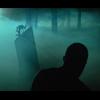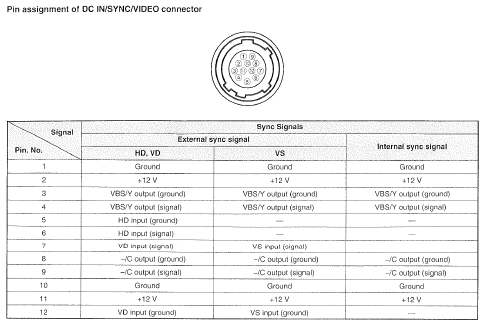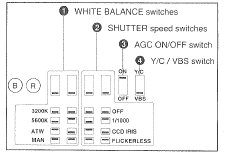-
Posts
93 -
Joined
-
Last visited
Everything posted by Nick G Smith
-
Ok, I have the answer thanks to Andrew Zorawski at Az-spectrum. Anyone else who wants to use a XC-999 for video assist use the following instructions. To get a color image for the XC 999 Pin 11 on the 12 pin Hirose connector has to be connected to +12V. pin 1 : 0V pin2 : +12VDC pin 3 : Video Out pin4 : Video GND pin11: +12VDC Pot 4 on VBS
-
I bought a Sony XC-999 for video assist . I am using the same Y cable as for a Sony Xc-75 but I am only getting a b/w image. The hirose 12pin cable is wired to a bnc on pins 3 Video output grnd and 4 Video output signal. Does anyone know if that is correct wiring for a colour video signal? Looks like I am only getting the luminance signal and no chroma. Pot 4 is switched to Y/C - but seems to make no difference on either setting. Nick
-

Adapting an Arri Standard Mount to BNCR?
Nick G Smith replied to XiaoSu Han's topic in Lenses & Lens Accessories
It certainly looks similar to the ones Les makes to PL mount. You can use the old Cooke Pancros on those adaptors as they can rotate in the sleeve but as D Goulder said you won't be able to see the focus marks unless you use a long lens. Stephen's mount looks like the same mount I once had on a Canon K35. -
'Hunger' 2008 Dir. Steve Mcqueen DOP Sean Bobbitt was shot on 2perf. http://www.arrimedia.com/Hunger.php I played with an Aaton Penelope at the BSC show in London - Aimimage who took over ICE may purchase one? Fantastic ergonomic camera, very quiet. I would jump at the chance to use one. Nick
-

Adapting an Arri Standard Mount to BNCR?
Nick G Smith replied to XiaoSu Han's topic in Lenses & Lens Accessories
I had an arri standard to BNCR with a number of other BNCR adaptors but unfortunately sold them last year. The Arri standard to BNCR is bottom right in picture. They can be found, trying calling a few rental companies that used to have BNCR cameras as they might have one that they are willing to get rid of. Nick -

De-squeeze monitor options for anamorphic?
Nick G Smith replied to Hunter Hampton's topic in Lenses & Lens Accessories
Transvideo Rainbow 2 and Cinemonitor 3 have an Anamorphic setting. I use them when I don't have a de-squeezer in the viewfinder/Video assist path. You can also use with Full and Underscan modes. Nick -

Help IDing Canon cinema lenses
Nick G Smith replied to Michael Panfeld's topic in Lenses & Lens Accessories
As D Goulder and Leo said these are BNC mount lenses made for non reflex rack over Mitchell cameras. The actual flange is the same between both mounts but as Leo says you will destroy the mirror on a reflex camera with a BNC lens. Check the distance between the VP BNCR flange and the OLPF on the Red One to check clearance. The difference between BNC and BNCR is that the R stands for Reflex and therefore the rear of the lens has to clear the mirror. Yours look like Canon still lenses rehoused to BNC whereas the K35s were designed for film, I would roughly date them from the '60s but Leo would know better. Interesting to see a lens close down to F 28. There is a Canon resource at http://www.canon.com/camera-museum/camera/index.html where they give a history of their Still lenses and you may be able to deduce which were used. -

Help IDing Canon cinema lenses
Nick G Smith replied to Michael Panfeld's topic in Lenses & Lens Accessories
Michael, email address sent to your inbox. -

Help IDing Canon cinema lenses
Nick G Smith replied to Michael Panfeld's topic in Lenses & Lens Accessories
Yes the 18mm K35s have different serial numbering than the other focal lengths starting with 1xxxx. I have an 18mm T1.5 with a serial no. 10088 and I am pretty sure it was made in the early '80s while the rest of my set have serial no.s starting 81 which I take as their year of manufacture. -

Help IDing Canon cinema lenses
Nick G Smith replied to Michael Panfeld's topic in Lenses & Lens Accessories
Can you post some larger images as I can't get beyond the thumbnails. As I understand it and I could be wrong ( Canon have never answered my queries about serial no.s unlike Zeiss ) the K35s start the serial no. with the year of manufacture i.e 78xxxx 81xxxx The earlier K35 Sets had a 55mm the later 50mm. The lenses were derived from the Canon Aspherical still lens and had open apertures ranging from T1.3 to T1.5 Other companies may have rehoused the still lenses to BNCR. -
Thanks Bruce. I was told about putting inserts in to pull the long lens back. I didn't know about a short lens being used. I'm going to pick up an old door and see what I can come up with! Nick
-
A question for someone who has an anamorphic door for a 2c. Does it turn through standard/anamorphic/closed without snagging on viewfinder lens? Reason I ask, I have an anamorphic door from a 2b, when the anamorphic insert is put in the 2c door it will only fit in the anamorphic position as it will catch on the extruded viewfinder lens in normal and closed positions. It is not an issue as I can change the insert to go spherical but I want to know if the design was changed for the 2c door. See pics. Nick
-
So CML are the old timers?!!!! Tim, I tried to replicate your ghosting issue on my 2C today with a Cooke 20-100 and I do not get any ghost image even if I'm moving my eye to see only half the gg. It's certainly what you could call a poop viewfinder compared to what you get on modern Arri's. Nick
-
I have never had that problem on a 2c. On the normal eyepiece I find that there is noticeable focus softening at the edges of the gg. This is overcome using a wide angle eyepiece. I find that there is only one position the eye can be in to see the whole frame. How can you move your eye off centre and see both sides of the frame? Does the ghosting appear when your eye is centred correctly? Is the ghosting apparent on the gg markings? I concur with Mr Goulder that you should check the setting of the gg, if you have a spare, swop them over and see if it makes a difference. Otherwise check with a collimater. Also look at your mirror shutter for any problems. Your description of the problem makes me think it feels like a slight fogging on the gg or mirror shutter but that sounds far too obvious. Nick
-
TV licence in the UK is £130 per year. If you have a tv you have to pay the licence otherwise they will send out detector vehicles and knock on your door and give you a hefty fine. I think that if you are over 70 years old you get a reduction or maybe it is free. The licence money only goes to fund the BBC. BBC channels therefore have no commercials. It is a contentious issue which can keep you in arguments for a long time if you can be bothered.
-
I have found that the 16mm and 32mm Standard speeds will vignette with S35. I have never liked using the 32mm on the standard set as it breathes more than the others - also is the same with the Ultraprimes - the 32mm breathes compared to the other focal lengths, I don't know if the 40mm has the same problem. Also check your zooms. Modern zooms should be ok, older zooms were made to cover Normal 35 frame so will vignette on the wider focal length.
-

Popular lenses during the 70's?
Nick G Smith replied to Kevin Curtin's topic in Lenses & Lens Accessories
Leo, Forgive me for my errors, I was only a kid at the time. You should do a FAQ on the history of lenses. Do you know what year Zeiss started the T* coating? The earliest Canon K35 serial No.s I've seen are from 1978 - I have a Canon still lens brochure from 1971 and the only fast lens is the 1.2 55mm FD. But mind you John Alcott used them on parts of 'Barry Lyndon' and that was 1974-75. -

Popular lenses during the 70's?
Nick G Smith replied to Kevin Curtin's topic in Lenses & Lens Accessories
No particular reason. I was just trying to think of anamorphic films from the '70s and 'Pat Garrett...' being one of my favourite westerns came to mind. I have no idea what lenses it was shot with but was most probably a Panavision shoot. -

Popular lenses during the 70's?
Nick G Smith replied to Kevin Curtin's topic in Lenses & Lens Accessories
As Max stated the Zeiss Superspeeds were introduced in the late '70s. A good history of Zeiss lenses at cinematechnic.com. The Canon K35 lenses were introduced around 1977-78 and maybe the Kowa primes around the same time. The Superspeeds and K35's were innovative as they were faster at T1.4/T1.3 than previous lenses. (Excepting Kubricks specially built T 0.7) Lens mounts would have been BNCR, Arri bayonet and standard. Arri introduced the PL mount with the 35BL2 or 3 most probably mid to late '70s. Then there were Balters, Super Balters, Cooke Pancros and Zeiss standards, Lomos and other Russian glass in the USSR The Cooke zooms were incredibly innovative and introduced in the '70s The 20-100 and later the 25-250. History of these lenses are on the Cooke website. Also the Angenieux Zooms were around. 25-250 and 17 -100 ?. Then a range of anamorphics - (Think of ' Pat Garrett and Billy the Kid' and many others) -
The old style wide angle eyepiece with threaded mount will fit the 2C, arri 3 and 35BL, SR1 + I think SR2. The newer one has a bayonet mount to fit 435, SR3 etc. Second hand Arri ones are about - also P&S technic, Kish and Denz -Deniz still make them. They do help on the 2C as you can see the whole gg without having to move your eyeball! Nick
-
I'll try putting them in the oven. I picked them up dirt cheap at a fire sale- set of 6.6x6.6 tiffen sfx - new, pouches and still in crepe paper but probably been sitting on a shelf for years. I checked them for scratches but did not see the fogging till I properly inspected them later. As Kevin says they are are a light fog sfx kind of filter now ! - problem is the fog is not consistant. If the oven trick doesn't work I'll bin them.
-
I have some Tiffen SFX filters that have developed what looks like fogging marks on the inner glass of the sandwich. They may have been kept in an unsuitable enviroment for some time. I've tried heating them with a hairdryer but can't seem to get rid of fogging. I will keep them in warm dry place for a while to see if it disappears. Anyone had the same problem - any solutions or are they ng? Nick
-
The cost of lenses is relative to demand and at the moment demand is high for 35mm glass so it is a sellers market. I've seen sets on sale from $1,500 to $14,000. It is possible to find a cheap set of K35s in bncr mounts. Converting them to PL can cost from $600 to $2000 per lens depending where you go. Nick
-
I think the auctions you saw were scams. You can get a bit of information on Canon lenses doing a search here and on CML. There have been a few questions about them recently so I will try give a bit of information I have gleaned. They are from the late 1970's early 1980's and marketed as Canon K35s and use aspherical elements. The 24mm, 55mm and 85mm derive from the canon FD aspherical still lens. They were originally made with bncr mounts with later models supplied through Optex with either or dual bncr or PL mounts. Other sets have been retrofitted or rehoused with PL mounts. Optex and I think Century used to rehouse the 15mm (or is it 14mm?) 100mm and 135mm and maybe others from non aspherical Canon FD lenses. The early sets, (Super Speeds?) consist of 18mm T1.5 cf 12", 24mm T1.5 cf 12", 35mm T1.3 cf 12", 55mm T 1.3 cf 24", 85mm T1.3 cf 36". I have an old Samuelsons catalogue from 1994 which has 3 sets in : Canon Super Speeds, Ultra Speeds and Mk11 Super Canon. The difference being that the Super Canons have a 50mm instead of the 55mm and the focus marks glow in the dark. As with the later versions of the FD still lenses they may have an improved lens coating. They have geared focus and aperture rings. Focus barrel movement on the 18mm/24mm/35mm is limited with approx 120º. The 55 and 85 are much better with approx 300º. The set I have is sharp (sharpest at T 2.8). I find the breathing minimal and I like the colour and feel these lens give but this will always be subjective to the use and user. The lens coatings are not as sophisticated as the comparable Zeiss lens and the flare from bare light sources can be unwanted. Ed Lachman recently used them on 'I'm not there'. The ASC article said K4s - I think this is maybe how the later K35s are designated, I could be wrong. He used a number of different lenses on that film - Cooke S4s and Pancros - Canon K4s - Cooke and Angenieux Zooms. A great film to compare different glass. I liked the look of the Canons in the segment with Heath Ledger and Charlotte Gainsbourg - I also liked the look of the Pancros and old zooms, but then I do have a great affection for the look of old lenses. Hope this helps. Nick
-
Have you tried Lee Gaither at CUP Camera as they may be able to make a new one for a competitive price. http://customupholsteryproducts.com/ Nick





